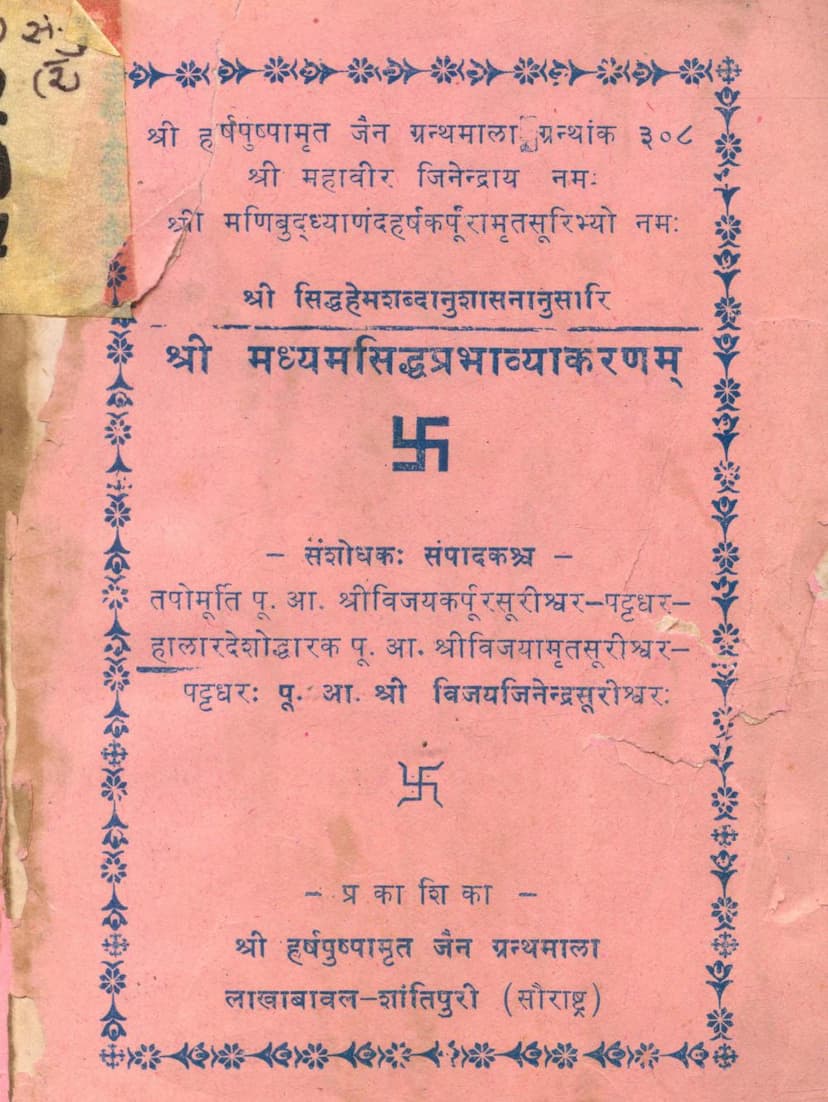Madhyam Siddh Prabha Vyakaranam
Added to library: September 2, 2025

Summary
Here's a comprehensive summary of the Jain text "Madhyam Siddh Prabha Vyakaranam" based on the provided pages:
Book Title: Madhyam Siddh Prabha Vyakaranam Author: Jinendrasuri Publisher: Harshpushpamrut Jain Granthmala Catalog Link: https://jainqq.org/explore/004483/1
Overview:
"Madhyam Siddh Prabha Vyakaranam" is a Jain grammatical treatise, structured to follow the principles of the renowned "Siddhahem Shabdānushāsanam." As indicated in the preface and author's note, this grammar is intended to be a more accessible and concise guide for students with moderate capabilities and limited time. It aims to simplify the study of Sanskrit grammar, enabling learners to grasp the fundamental principles and, in turn, their spiritual knowledge ("tattva").
Key Features and Content:
The book systematically covers the various aspects of Sanskrit grammar, presented in a clear and logical order. The table of contents (Page 5) reveals the following major sections:
-
Sanjna Prakaran (Chapter on Nomenclature/Definitions): This foundational chapter defines essential grammatical terms and concepts. It covers vowels (swara), consonants (vyanjana), their classification (e.g., short, long, pluta), places of articulation (sthana), efforts (prayatna), classification of consonants (e.g., voiceless-ghosha, voiced-ghoshawan), and other vital terminology.
-
Svara Sandhi (Vowel Combination): This section details the rules governing the joining of vowels, including various transformations and sandhi rules that occur when vowels meet. Examples illustrate how different vowel combinations result in specific phonetic changes.
-
Asandhi (Absence of Sandhi): Conversely, this chapter outlines the instances where sandhi rules are not applied, preserving the original forms of vowels.
-
Vyanjana Sandhi (Consonant Combination): This extensive chapter explains the complex rules of consonant assimilation and transformation when consonants combine. It covers various changes based on the position and type of consonants involved, including assimilation to the following consonant and changes at the end of words (padanta).
-
Sasandhi (Sam-Sandhi): This section focuses on the sandhi rules involving the 'sam' prefix and its interactions with other sounds.
-
Svaranta Pulinga (Vowel-Ending Masculine Nouns): This chapter delves into the declension of masculine nouns that end in vowels, explaining how they change in different cases and numbers.
-
Svaranta Stri-linga (Vowel-Ending Feminine Nouns): Similar to the masculine section, this covers the declension of feminine nouns ending in vowels.
-
Svaranta Napunsaka-linga (Vowel-Ending Neuter Nouns): This section details the declension of neuter nouns ending in vowels.
-
Vyanjana-anta Pulinga (Consonant-Ending Masculine Nouns): This chapter addresses the declension of masculine nouns ending in consonants, outlining their various forms.
-
Vyanjana-anta Stri-linga (Consonant-Ending Feminine Nouns): This covers the declension of feminine nouns ending in consonants.
-
Vyanjana-anta Napunsaka-linga (Consonant-Ending Neuter Nouns): This section explains the declension of neuter nouns ending in consonants.
-
Yushmad-Ashmadi (Pronouns 'You' and 'I'): This chapter focuses on the declension and usage of the personal pronouns "yushmad" (you) and "ashmadi" (I).
-
Avyayāni (Indeclinables/Adverbs): This section defines and explains the nature of indeclinable words, which do not change their form regardless of case, number, or gender. It includes a list of common indeclinables and their usage.
-
Stri-pratyaya (Feminine Suffixes): This chapter details the suffixes used to form feminine nouns and adjectives.
-
Kārakāni (The Six Cases/Agents): This is a significant portion of the grammar, explaining the functions of the six grammatical cases (karta, karma, karana, sampradana, apadana, adhikaraṇa) and how they relate to verbs and sentence structure.
-
Samāsaḥ (Compound Words): This section explains the formation and rules of Sanskrit compound words, categorizing them into different types (e.g., Avyayībhāva, Tatpurusha, Karmadhāraya, Bahuvrīhi, Dvandva).
-
Taddhita-pratyayaḥ (Derivative Suffixes): This chapter covers the suffixes that are added to roots or nouns to form new words, often changing their meaning or grammatical category.
-
Ākhyāta-prakaraṇam (Verbs): This is another extensive section, detailing the conjugation of verbs. It covers different tenses (present, past, future), moods (imperative, optative), voices (parasmaipada, ātmanepada, ubhayapada), and the formation of verb roots.
-
Kṛdanta-prakaraṇam (Verbal Participles/Nouns): This final chapter explains the formation and usage of kṛt suffixes, which derive nouns and adjectives from verb roots.
Author's and Publisher's Intent:
The preface and author's note highlight the aim of the book:
- To provide a grammar that is accessible to those with "medium power" (madhyam shakti) and "limited time" (alp vakt).
- To serve as a helpful guide that follows the "Siddhahem Shabdānushāsanam" in its principles, making it easier for students.
- The publisher expresses joy in bringing this work to light, acknowledging the contributions of the editors and the support of the Jamnagar Oswal Jain Sangha.
Overall Significance:
"Madhyam Siddh Prabha Vyakaranam" appears to be a valuable resource for Jain students seeking to learn Sanskrit grammar without the overwhelming complexity of larger, more exhaustive texts. By adhering to the established framework of "Siddhahem" while offering a more condensed approach, it aims to facilitate a deeper understanding of grammar, which in turn supports the study of Jain Agamas and philosophical literature. The text emphasizes the connection between grammatical knowledge and the pursuit of spiritual truths.